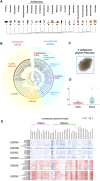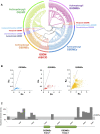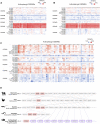New insights into the evolutionary dynamic and lineage divergence of gasdermin E in metazoa
- PMID: 35938154
- PMCID: PMC9355259
- DOI: 10.3389/fcell.2022.952015
New insights into the evolutionary dynamic and lineage divergence of gasdermin E in metazoa
Abstract
Gasdermin (GSDM) is a family of pore-forming proteins that induce pyroptosis. To date, the origin and evolution of GSDM in Metazoa remain elusive. Here, we found that GSDM emerged early in Placozoa but is absent in a large number of invertebrates. In the lower vertebrate, fish, three types of GSDME, i.e., GSDMEa, GSDMEb, and a previously unreported type (designated GSDMEc), were idenitied. Evolutionarily, the three GSDMEs are distinctly separated: GSDMEa is closely related to tetrapod GSDME; GSDMEb exists exclusively in fish; GSDMEc forms the lineage root of tetrapod GSDMA/B/C/D. GSDMEc shares conserved genomic features with and is probably the prototype of GSDMA, which we found existing in all tetrapod classes. GSDMEc displays fast evolutionary dynamics, likely as a result of genomic transposition. A cross-metazoan analysis of GSDME revealed that GSDMEa shares a conserved caspase recognition motif with the GSDME of tetrapods and cnidarians, whereas GSDMEb has a unique caspase recognition motif similar to that of mammalian GSDMD, and GSDMEc exhibits no apparent caspase recognition motif. Through functional test, four highly conserved residues in vertebrate GSDME proved to be essential to auto-inhibition. Together our results provide new insights into the origin, evolution, and function of metazoan GSDMs.
Keywords: auto-inhibition; evolution; fish; gasdermin; metazoan; recognition motif.
Copyright © 2022 Yuan, Jiang, Qin and Sun.
Conflict of interest statement
The authors declare that the research was conducted in the absence of any commercial or financial relationships that could be construed as a potential conflict of interest.
Figures




Similar articles
-
Teleost GSDMEc regulates GSDMEa-mediated pyroptosis.J Adv Res. 2025 Apr 8:S2090-1232(25)00226-7. doi: 10.1016/j.jare.2025.04.007. Online ahead of print. J Adv Res. 2025. PMID: 40210150
-
Zebrafish gasdermin E cleavage-engaged pyroptosis by inflammatory and apoptotic caspases.Dev Comp Immunol. 2021 Nov;124:104203. doi: 10.1016/j.dci.2021.104203. Epub 2021 Jul 10. Dev Comp Immunol. 2021. PMID: 34252476
-
GSDMEa-mediated pyroptosis is bi-directionally regulated by caspase and required for effective bacterial clearance in teleost.Cell Death Dis. 2022 May 24;13(5):491. doi: 10.1038/s41419-022-04896-5. Cell Death Dis. 2022. PMID: 35610210 Free PMC article.
-
Mechanisms of Gasdermin Family Members in Inflammasome Signaling and Cell Death.J Mol Biol. 2018 Sep 14;430(18 Pt B):3068-3080. doi: 10.1016/j.jmb.2018.07.002. Epub 2018 Jul 7. J Mol Biol. 2018. PMID: 29990470 Review.
-
Structural Insight of Gasdermin Family Driving Pyroptotic Cell Death.Adv Exp Med Biol. 2019;1172:189-205. doi: 10.1007/978-981-13-9367-9_9. Adv Exp Med Biol. 2019. PMID: 31628657 Review.
Cited by
-
Emerging mechanisms and functions of inflammasome complexes in teleost fish.Front Immunol. 2023 Feb 16;14:1065181. doi: 10.3389/fimmu.2023.1065181. eCollection 2023. Front Immunol. 2023. PMID: 36875130 Free PMC article. Review.
-
The Evolution and Biological Activity of Metazoan Mixed Lineage Kinase Domain-Like Protein (MLKL).Int J Mol Sci. 2024 Oct 2;25(19):10626. doi: 10.3390/ijms251910626. Int J Mol Sci. 2024. PMID: 39408954 Free PMC article.
-
Pufferfish gasdermin Ea is a significant player in the defense against bacterial pathogens.Mar Life Sci Technol. 2024 Jun 28;6(3):462-474. doi: 10.1007/s42995-024-00237-x. eCollection 2024 Aug. Mar Life Sci Technol. 2024. PMID: 39219679 Free PMC article.
-
Characterization of GSDME in amphioxus provides insights into the functional evolution of GSDM-mediated pyroptosis.PLoS Biol. 2023 May 3;21(5):e3002062. doi: 10.1371/journal.pbio.3002062. eCollection 2023 May. PLoS Biol. 2023. PMID: 37134086 Free PMC article.
-
The evolutionary diversification and antimicrobial potential of MPEG1 in Metazoa.Comput Struct Biotechnol J. 2023 Nov 19;21:5818-5828. doi: 10.1016/j.csbj.2023.11.032. eCollection 2023. Comput Struct Biotechnol J. 2023. PMID: 38213882 Free PMC article.
References
-
- Angosto-Bazarra D., Alarcon-Vila C., Hurtado-Navarro L., Banos M. C., Rivers-Auty J., Pelegrin P., et al. (2022). Evolutionary analyses of the gasdermin family suggest conserved roles in infection response despite loss of pore-forming functionality. BMC Biol. 20 (1), 9. 10.1186/s12915-021-01220-z - DOI - PMC - PubMed
LinkOut - more resources
Full Text Sources

